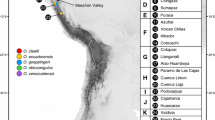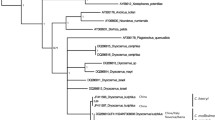Abstract
Allothrombium pulvinum Ewing is a common natural enemy of aphids and some other arthropods. So far, there are no studies that have addressed genetic variation of this predatory mite. We investigated genetic variation of A. pulvinum across its whole known range in Iran. A 410 bp portion of the mitochondrial cytochrome c oxidase subunit I gene (coxI) and 797–802 bp portion of the internal transcribed spacer 2 of rDNA (ITS2) were sequenced for 55 individuals from 11 populations, resulting in 12 and 26 haplotypes, respectively. In the coxI region, haplotype and nucleotide diversities varied among populations from 0.00 to 0.90 and from 0.0000 to 0.0110, respectively. In the ITS2 region they varied from 0.20 to 0.91 and from 0.0006 to 0.0023, respectively. For both gene regions the highest haplotype and nucleotide diversities were detected in population Mahmoud Abad from northern Iran. Statistically significant population differentiation (F ST) was detected in most pair-wise population comparisons. The results of population differentiation for both gene regions were generally congruent indicating that A. pulvinum from Iran consists of genetically different populations. This suggests that A. pulvinum comprises at least two geographically distinct populations or even more than one species. This study is an initial step towards understanding genetic variation of A. pulvinum, a taxon for which little molecular information is available. More intensive sampling and analysis of additional DNA regions are necessary for more detailed classification of this taxon.


Similar content being viewed by others
References
Bandelt HJ, Forster P, Rohl A (1999) Median-joining networks for inferring intraspecific phylogenies. Mol Biol Evol 16:37–48
Caterino MS, Cho S, Sperling FAH (2000) The current state of insect molecular systematics: a thriving tower of babel. Annu Rev Entomol 45:1–54. doi:10.1146/annurev.ento.45.1.1
Chen PR, Zhang Z-Q (1991) Biology of Allothrombium pulvinum Ewing (Acari: Trombidiidae) and its impact on twospotted spider mite (Acari: Tetranychidae) in cotton. J Appl Ent 112:31–37
Cruickshank RH (2002) Molecular markers for the phylogenetics of mites and ticks. Syst Appl Acarol 7:3–14
Filatov DA (2002) PROSEQ: a software for preparation and evolutionary analysis of DNA sequence data sets. Mol Ecol Notes 2:621–624. doi:10.1046/j.1471-8286.2002.00313.x
Hall TA (1999) Bioedit: a user-friendly biological sequence alignment editor and analysis program for Windows 95/98/NT. Nucl Acids Symp 41:95–98
Hammer Ø, Harper DAT, Ryan PD (2001) PAST: paleontological statistics software package for education and analysis. Palaeontol Electronica 4:1–9
Hosseini M, Hatami B, Saboori A (2002) Host preference by Allothrombium pulvinum Ewing (Acari: Trombidiidae) larvae on aphids: Macrosiphum rosae, Aphis gossypii and Hyalopterus amygdali (Homoptera: Aphididae). Exp Appl Acarol 27:297–302. doi:10.1023/A:1023359130396
Hosseini M, Hatami B, Saboori A, Allahyari H, Ashouri A (2005) Predation by Allothrombium pulvinum on the spider mite Tetranychus urticae and Amphitetranychus viennensis: predation rate, prey preference and functional response. Exp Appl Acarol 37:173–181. doi:10.1007/s10493-005-2846-6
Hudson RR, Boos DD, Kaplan NL (1992) A statistical test for detecting population subdivision. Mol Biol Evol 9:138–151
Krantz GW (1978) A manual of acarology, 2nd edn. Oregon State University Book Stores, Corvallis, OR
Lunt DH, Zhang DX, Szymura JM, Hewitt GM (1996) The insect cytochrome oxidase I gene: evolutionary patterns and conserved primers for phylogenetic studies. Insect Mol Biol 5:153–165. doi:10.1111/j.1365-2583.1996.tb00049.x
Moss WW (1962) The immature stages of the red velvet mite Allothrombium lerouxi (Acari: Trombidiidae). Ann Entomol Soc Am 55:295–303
Navajas M, Fenton B (2000) The application of molecular markers in the study of diversity in acarology: a review. Exp Appl Acarol 24:751–774. doi:10.1023/A:1006497906793
Navajas M, Cotton D, Kreiter S, Gutierrez J (1992) Molecular approach in spider mites (Acari: Tetranychidae): preliminary data on ribosomal DNA sequences. Exp Appl Acarol 15:211–218. doi:10.1007/BF01246563
Navajas M, Gutierrez J, Bonato O, Bolland HR, Mapangou-Divassa S (1994) Intraspecific diversity of the cassava green mite Mononychellus progresivus (Acari: Tetranychidae) using comparisons of mitochondrial and nuclear ribosomal DNA sequences and cross-breeding. Exp Appl Acarol 18:351–360. doi:10.1007/BF00116316
Navajas M, Fournier D, Lagnel J, Boursot P (1996a) Mitochondrial COI sequences in mites: evidence for variation in base composition. Insect Mol Biol 5:1–5. doi:10.1111/j.1365-2583.1996.tb00102.x
Navajas M, Gutierrez J, Lagnel J (1996b) Mitochondrial cytochrome oxidase I in tetranychid mites: a comparison between molecular phylogeny and changes of morphological and life history traits. Bull Entomol Res 86:407–417
Navajas M, Gutierrez J, Gotoh T (1997) Convergence of molecular and morphological data reveals phylogenetic information on Tetranychus species and allows the restoration of the genus Amphitetranychus (Acari: Tetranychidae). Bull Entomol Res 87:283–288
Navajas M, Lagnel J, Gutierrez J, Boursot P (1998) Species wide homogeneity of nuclear ribosomal ITS2 sequences in the spider mite Tetranychus urticae contrasts with extensive mitochondrial COI polymorphism. Heredity 80:742–752. doi:10.1046/j.1365-2540.1998.00349.x
Navajas M, Gutierrez J, Lagnel J, Fauvel G, Gotoh T (1999a) DNA sequences and cross-breeding experiments in the hawthorn spider mite Amphitetranychus viennensis reveal high genetic differentiation between Japanese and French populations. Entomol Exp Appl 90:113–122. doi:10.1023/A:1003524217318
Navajas M, Lagnel J, Fauvel G, De Moraes G (1999b) Sequence variation of ribosomal internal transcribed spacers (ITS) in commercially important Phytoseiidae mites. Exp Appl Acarol 23:851–859. doi:10.1023/A:1006251220052
Navia D, De Moraes G, Roderick G, Navajas M (2005) The invasive coconut mite Aceria guerreronis (Acari: Eriophyidae): origin and invasion sources inferred from mitochondrial (16S) and nuclear (ITS) sequences. Bull Entomol Res 95:505–516. doi:10.1079/BER2005382
Nei M (1987) Molecular evolutionary genetics. Columbia University Press, New York
Nishimura S, Hinomoto N, Takafuji A (2007) The genetic variations among populations of Tetranychus kanzawai complex (Acari: Tetranychidae) indicated by using mitochondrial, ribosomal, and microsatellite DNA markers. J Acarol Soc Jpn 16:109–119. doi:10.2300/acari.16.109
Osakabe M, Sakagami Y (1993) Protein differences detected by two-dimensional electrophoresis among local populations of Panonychus citri (McGregor) (Acari: Tetranychidae) in Japan. App Ent Zool 28:497–502
Ros VID, Breeuwer JAJ (2007) Spider mite (Acari: Tetranychidae) mitochondrial COI phylogeny reviewed: host plant, relationships, phylogeography, reproductive parasites and barcoding. Exp Appl Acarol 42:239–262. doi:10.1007/s10493-007-9092-z
Rozas J, Sanchez-Del Barrio JC, Messeguer X, Rozas R (2003) DnaSP, DNA polymorphism analysis by the coalescent and other methods. Bioinformatics 19:2496–2497. doi:10.1093/bioinformatics/btg359
Rozen S, Skaletsky H (2000) Primer3 on the WWW for general users and for biologist programmers. In: Kravetz S, Misener S (eds) Bioinformatics Methods and Protocols. Humana Press, New Jersey
Saboori A, Zhang Z-Q (1996) Biology of Allothrombium pulvinum Ewing (Acari: Trombidiidae) in West Mazandaran, Iran. Exp Appl Acarol 20:137–142. doi:10.1007/BF00051479
Saboori A, Hosseini M, Hatami B (2003) Preference of adults of Allothrombium pulvinum Ewing (Acari; Trombidiidae) for eggs of Planococcus citri (Risso) and Pulvinaria aurantii (Cockerell) on citrus leaves in the laboratory. Syst Appl Acarol 8:49–54
Saboori A, Hosseini M, Asadi M (2007) Acari of Iran, vol 1. Parasitengone mites of Iran, University of Tehran Press
Saitou N, Nei M (1987) The neighbor-joining method: a new method for reconstructing phylogenetic trees. Mol Biol Evol 4:406–425
Smouse PE, Long JL, Sokal RR (1986) Multiple regression and correlation extensions of the Mantel test of matrix correspondence. Syst Zool 35:627–632. doi:10.2307/2413122
Tajima F (1989) Statistical method for testing the neutral mutation hypothesis by DNA polymorphism. Gene 123:585–595
Tamura K, Dudley J, Nei M, Kumar S (2007) MEGA4: molecular evolutionary genetics analysis (MEGA) software version 4.0. Mol Biol Evol 24:1596–1599. doi:10.1093/molbev/msm092
Tsagkarakou A, Navajas M, Lagnel J, Pasteur N (1997) Population structure in the spider mite Tetranychus urticae (Acari: Tetranychidae) from crete based on multiple allozymes. Heredity 78:84–92
Wohltmann A (2000) The evolution of life histories in parasitengona (Acari: Prostigmata). Acarologia 41:145–204
Xie L, Xie R-R, Zhang K-J, Hong X-Y (2008) Genetic relationship between the carmine spider mite Tetranychus cinnabarinus (Boisduval) and the two-spotted mite T. urticae Koch in China based on the mtDNA COI and rDNA ITS2 sequences. Zootaxa 1726:18–32
Zhang Z-Q (1991) Parasitism of Acyrthosiphon pisum by Allothrombium pulvinum (Acariformes: Trombidiidae): host attachment site, host size selection, superparasitism and affect on host. Exp Appl Acarol 11:137–147. doi:10.1007/BF01246086
Zhang Z-Q (1992a) The adaptive significance of superparasitism in a protelean parasite, Allothrombium pulvinum (Acari: Trombidiidae). Oikos 65:167–168. doi:10.2307/3544900
Zhang Z-Q (1992b) Functional response of Allothrombium pulvinum deutonymph (Acari: Trombidiidae) on twospotted spider mites (Acari: Tetranychidae). Exp Appl Acarol 15:249–257. doi:10.1007/BF01246566
Zhang Z-Q (1992c) Notes on the occurrence and distribution of the biocontrol agent, Allothrombium pulvinum Ewing (Acari:Trombidiidae), in a peach orchard in China. J Entomol 113:13–17
Zhang Z-Q (1992d) Phototactic and geotactic responses in Allothrombium pulvinum larvae (Acari: Trombidiidae). Exp Appl Acarol 15:41–47. doi:10.1007/BF01193966
Zhang Z-Q (1998) Biology and ecology of trombidiid mites (Acari: Trombidioidea). Exp Appl Acarol 22:139–155. doi:10.1023/A:1006002028430
Zhang Z-Q, Chen PR (1993) Parasitism of Aphis gossypii (Homoptera: Aphididae) by Allothrombium pulvinum larvae (Acari: Trombidiidae) in cotton field: spatial dispersion and density dependence. Exp Appl Acarol 17:905–912. doi:10.1007/BF02328067
Zhang Z-Q, Faraji F (1994) Notes on Allothrombium pulvinum Ewing (Acari: Trombidiidae) new to the fauna of Iran. Acarologia 35:357–360
Zhang Z-Q, Norbakhsh H (1995) A new genus and three new species of mites (Acari: Trombidiidae) described from larvae ectoparasitic on aphids from Iran. Eur J Entomol 92:705–718
Zhang Z-Q, Xin JL (1989) Biology of Allothrombium pulvinum (Acariformes: Trombidiidae), a potential biological control agent of aphids in China. Exp Appl Acarol 6:101–108. doi:10.1007/BF01201641
Acknowledgments
We are especially grateful to Dr. X-R Wang, Umeå University, Sweden, for helpful discussion and comments on the manuscript. We also thank Dr. Gholamhossein Tahmasbi, Pest and Plant Disease Research Institute, Iran, for kindly helping in sampling as well as Ms. Mitra Moezi-pour who helped at the time of field collection. This work was supported by the research grants from Ministry of Education, Culture, Sports, Science and Technology to A.E.S. and N.I. and from the University of Tehran to A.S.
Author information
Authors and Affiliations
Corresponding author
Rights and permissions
About this article
Cite this article
Khalili Mahani, M., Inomata, N., Saboori, A. et al. Genetic variation in populations of Allothrombium pulvinum (Acari: Trombidiidae) from Northern Iran revealed by mitochondrial coxI and nuclear rDNA ITS2 sequences. Exp Appl Acarol 48, 273–289 (2009). https://doi.org/10.1007/s10493-009-9241-7
Received:
Accepted:
Published:
Issue Date:
DOI: https://doi.org/10.1007/s10493-009-9241-7




